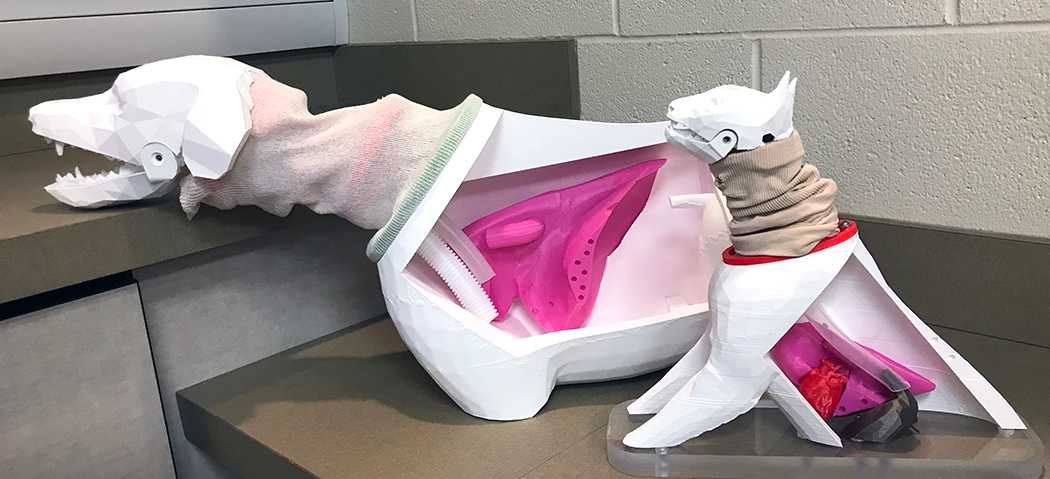
Model Feeding Tubes Provide Hands-On Experience to Student Veterinarians
January 19, 2023
(Banner image: Models in a cat and dog version allow students to practice placing feeding tubes on both species.)
Feeding tubes are an important component in veterinary medicine, when caring for pets who are unwell and unable to eat.
“The placement of feeding tubes is an essential skill for a graduating veterinarian, but the reality is, in general practice, feeding tubes may not be placed as often as they could be,” says veterinary clinical nutritionist Dr. Caitlin Grant.
A professor in the Ontario Veterinary College’s (OVC) Department of Clinical Studies, Grant also holds the Nestlé Purina Professorship in Companion Animal Nutrition, with an emphasis on teaching and learning in OVC’s nutrition curriculum for student veterinarians.
When Nestlé Purina Petcare Canada recently provided funds for OVC to purchase feeding tube models, instead of purchasing what was on the market already, Grant’s team worked with a company to design and print custom 3D models specifically designed for practicing placing feeding tubes.

Mozzon, right, practice placing a feeding tube during the nutrition
lab.
“We hope that with the use of these models, students will have the opportunity to refine their technique and build confidence before performing the procedure on a live patient,” says Grant.
Grant’s team partnered with 3DBits, based in the United Kingdom, to customize a design used previously in feeding tube labs, allowing the team to make some improvements to better suit their needs at OVC.
The custom models can be used for placement of four types of feeding tubes: NE (naso-esophageal) – nose to esophagus; NG (naso-gastric) – nose to stomach; E (esophagostomy) – esophagus; and Orogastric – mouth to stomach (this one is not very commonly done but technically the models allow for the team to do this).
Typically, an NE or NG tube is used for short-term feeding with a liquid diet while in the hospital. Tube placement does not require general anesthesia, but the pet cannot go home with this type of tube. An E-tube is placed, while under anesthesia, when longer-term nutritional support is needed. Pet parents can be taught how to manage and feed the pet through the tube at home.
They also got models in a cat and dog version so the students can practice on both species.
The nutrition team plans to use these custom models in the small animal clinical nutrition rotation elective for Phase 4 student veterinarians in their final year of the DVM program and make them available for Phase 4 students on other clinical rotations, such as small animal internal medicine, surgery and emergency and critical care, as well as in labs run by the OVC student nutrition club.
Grant worked with Nestlé Purina, the student nutrition club, and her team to organize an initial feeding tube lab with the new models. Open to DVM students across all four years of the program, the voluntary lab in late-November 2022 was a huge success, says Grant.

through feeding tubes.
During the lab, students broke into small groups and rotated through five stations. First up was a Purina resource/information station led by Purina representative Dr. Asha Hoffland. Station two featured E-tube placement with models led by Shoshana Verton-Shaw, Registered Veterinary Technician and Veterinary Technician Specialist in Nutrition. Next up was a “messy” station, led by Dr. Francisco Poblanno, second year clinical nutrition resident, where students used a variety of critical care diets and practiced putting them through feeding tubes. Station four featured NE/NG placement with models, led by OVC clinical nutrition resident Dr. Erico Ribeiro; and Grant led a diet plan/calculation station where students practiced creating a feeding plan for a patient including diet selection, energy and calorie target per day, food volume and feeding frequency.
OVC Class of 2024 DVM students Jessica Sun and Christina Mozzon, appreciated the hands-opportunities. "The tube feeding lab was very informative and was a great review of the knowledge we had! In addition, it was so cool to be able to see and use the 3D models that they had available for us."
As a fun addition, the feeding tube models will sport a Nestle Purina collar with name tags for each of them - NEd (after NE tube); Esophagus (after E-tube); and PEGasus (after PEG tube). A naming contest held during the feeding tube lab drew suggestions for a name for the fourth model, with Tuba taking the prize.
.png)